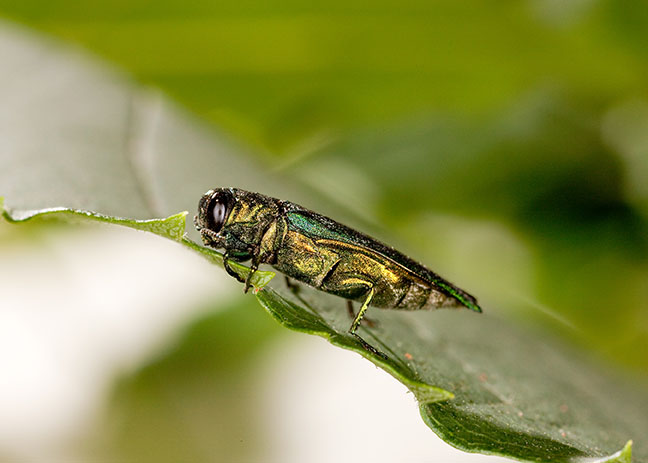By Ginger Nickerson
The week of May 22-28 has been designated National Emerald Ash Borer Awareness Week to help increase public awareness of this tree-killing beetle and the damage it can cause to all species of native ash trees within the Fraxinus genus.
The emerald ash borer (EAB), a native of southeast Asia, was first detected in Michigan in 2002. It was initially confirmed in Vermont in 2018 in Orange County and has now been confirmed in all counties except Essex County.
We have learned from municipalities in the Midwest that have been dealing with EAB for two decades that the more time a town or city has to plan for the removal or treatment of ash trees on municipally managed lands, the better they are able to manage the financial costs and impact of the beetle.
Towns may choose to treat some public ash trees with pesticides, which is costly, but may be the only viable option to save a tree. However, this must be done before the beetle is well-established in the tree. If not treated, ash trees will die and potentially create a hazard along roads and other public areas.
Once an adult EAB starts laying eggs in an ash tree, it can take three to five years for enough larvae to build up under the bark for the tree to start showing symptoms. Because of this EAB can be hidden in plain sight, and ash trees in an area with confirmed infestations may still look fine.
It can take up to 10 years from when EAB first arrives in an area before ash trees begin dying off at a large or landscape scale. That is why communities throughout Vermont should start planning now for how they will deal with ash trees on municipal lands.
The first step for any municipality to establish an ash management strategy is to inventory the ash trees on municipal lands. This includes shade trees on streets, parking lots and green spaces, town forests and municipal rights-of-way. Inventories can range from simple paper-based tally sheets to using GIS software to create digitized maps.
The Vermont Urban and Community Forestry of the Vermont Dept. of Forests, Parks and Recreation provides resources and direct technical assistance to design and conduct ash inventories. Its website has many resources including templates for writing ash management plans, tools to calculate the costs of different management scenarios, case studies from other municipalities and examples of documents, such as letters to residents and contracts with tree removal companies.
Program staff Ginger Nickerson and Joanne Garton are available to give presentations on EAB and provide technical assistance to municipalities, including assistance to conduct ash tree inventories.
Community members can do their part to scout for this pest and report any trees suspected of being infested with EAB by uploading photographs via the “Report It!” button at vtinvasives.org. You can learn how to identify ash trees and the signs and symptoms of the pest at vtinvasives.org/invasive/emerald-ash-borer. This website also links to a map of EAB infestations, created by the Vermont Agency of Natural Resources, which shows a 10-mile radius around each confirmed infestation. Areas marked in yellow indicate a high likelihood of other ash trees being infested with EAB. The areas in orange and red have a more established EAB infestation level.
Over time, the EAB infestation in Vermont will continue to spread. State agencies and conservation organizations are helping manage this pest, but more needs to be done to avoid accelerating its spread and unnecessary management costs. Recommendations can be found at go.uvm.edu/ash-borer-spread.




